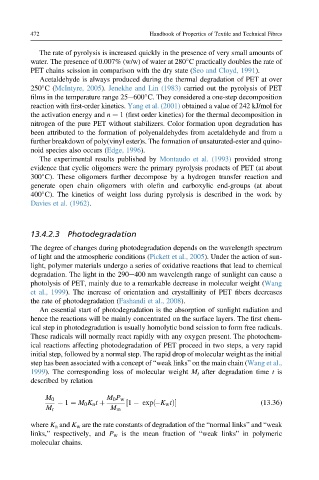Page 499 - Handbook of Properties of Textile and Technical Fibres
P. 499
472 Handbook of Properties of Textile and Technical Fibres
The rate of pyrolysis is increased quickly in the presence of very small amounts of
water. The presence of 0.007% (w/w) of water at 280 C practically doubles the rate of
PET chains scission in comparison with the dry state (Seo and Cloyd, 1991).
Acetaldehyde is always produced during the thermal degradation of PET at over
250 C(McIntyre, 2005). Jenekhe and Lin (1983) carried out the pyrolysis of PET
films in the temperature range 25e600 C. They considered a one-step decomposition
reaction with first-order kinetics. Yang et al. (2001) obtained a value of 242 kJ/mol for
the activation energy and n ¼ 1(first order kinetics) for the thermal decomposition in
nitrogen of the pure PET without stabilizers. Color formation upon degradation has
been attributed to the formation of polyenaldehydes from acetaldehyde and from a
further breakdown of poly(vinyl ester)s. The formation of unsaturated-ester and quino-
noid species also occurs (Edge, 1996).
The experimental results published by Montaudo et al. (1993) provided strong
evidence that cyclic oligomers were the primary pyrolysis products of PET (at about
300 C). These oligomers further decompose by a hydrogen transfer reaction and
generate open chain oligomers with olefin and carboxylic end-groups (at about
400 C). The kinetics of weight loss during pyrolysis is described in the work by
Davies et al. (1962).
13.4.2.3 Photodegradation
The degree of changes during photodegradation depends on the wavelength spectrum
of light and the atmospheric conditions (Pickett et al., 2005). Under the action of sun-
light, polymer materials undergo a series of oxidative reactions that lead to chemical
degradation. The light in the 290e400 nm wavelength range of sunlight can cause a
photolysis of PET, mainly due to a remarkable decrease in molecular weight (Wang
et al., 1999). The increase of orientation and crystallinity of PET fibers decreases
the rate of photodegradation (Fashandi et al., 2008).
An essential start of photodegradation is the absorption of sunlight radiation and
hence the reactions will be mainly concentrated on the surface layers. The first chem-
ical step in photodegradation is usually homolytic bond scission to form free radicals.
These radicals will normally react rapidly with any oxygen present. The photochem-
ical reactions affecting photodegradation of PET proceed in two steps, a very rapid
initial step, followed by a normal step. The rapid drop of molecular weight as the initial
step has been associated with a concept of “weak links” on the main chain (Wang et al.,
1999). The corresponding loss of molecular weight M t after degradation time t is
described by relation
M 0 M 0 P w
1 ¼ M 0 K n t þ ½1 expð K w tÞ (13.36)
M t M m
where K n and K w are the rate constants of degradation of the “normal links” and “weak
links,” respectively, and P w is the mean fraction of “weak links” in polymeric
molecular chains.

